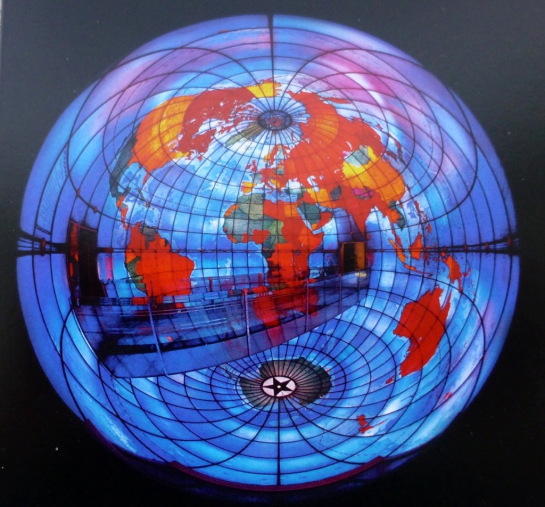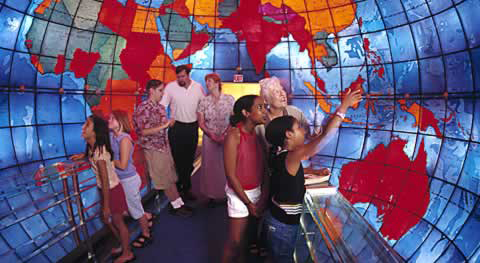“The Mapparium is a three-story tall glass globe of stained glass that is viewed from a 30-foot-long (9.1 m) bridge through its interior. It is a unique exhibit at The Mary Baker Eddy Library in Boston, Massachusetts. Built in 1935 and based upon Rand McNally political maps published the previous year, the Mapparium shows the political world as it was at that time, including such long-disused labels as Italian East Africa and Siam, as well as more-recently defunct political entities such as the Soviet Union. In 1939, 1958, and 1966 the Church considered updating the map, but rejected it on the basis of cost and the special interest it holds as an historical artifact.
In the 1930s, the Christian Science Monitor, a successful newspaper, and Christian Science Church officials wanted a suitably impressive addition to the new Christian Science Publishing Company headquarters. Inspired by the famous spinning globe in the lobby of the New York Daily News building, they commissioned architect Chester Lindsay Churchill to design the Mapparium.
The 608 stained glass panels were produced by the Rambusch Company of New York, and the Mapparium was opened to the public on June 1, 1935. The Mapparium was closed in 1998 for a four-year cleaning and renovation. It reopened in 2002 as an exhibit of The Mary Baker Eddy Library and now features a sound-and-light-show that illustrates how the world has changed since 1935. Computer-controlled lighting by the Color Kinetics company provides effects and highlights regions as the narration discusses them. The stained glass restoration was performed by the Boston-area firm Serpentino Stained Glass.
The Mapparium was designed to allow the countries of the world to be viewed in accurate geographical relationship to each other. It is usually assumed that a globe solves this problem; but since it is viewed from the outside, different parts of the globe are at different distances from the eye and are thus distorted by perspective. Hence, the specially accurate effect gained by viewing the Mapparium—a mirror-image, concave reversal of the Earth—from within. This is the only configuration that places the eye at the same distance from every point on the map.
The hard spherical surface of the globe reflects sound and produces striking acoustical effects. It forms a remarkable whispering gallery so that visitors standing at corresponding locations near opposite ends of the bridge can speak to each other and be heard as if they were standing next to each other. One visitor writes: ‘There are many whispering galleries around the world, such as in St Paul’s Cathedral in London, or the Echo Wall in Beijing’s Temple of Heaven. However, the Mapparium is different in that speaking in any direction, since it is a full sphere, will result in the same effect. Furthermore, standing in the middle of the sphere and speaking produces the unnerving effect of hearing yourself in surround sound with startling clarity'” (source).
Editor’s note: Many thanks to Meryl Wieder, our ex-MSO, for suggesting this material.




